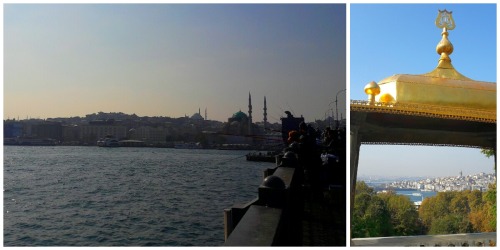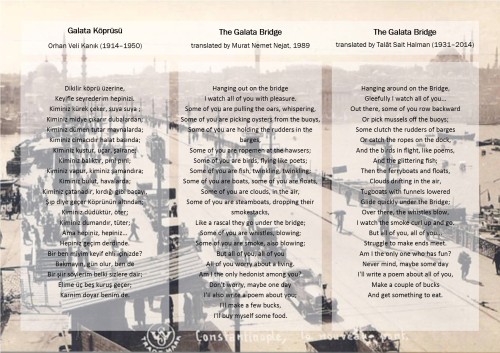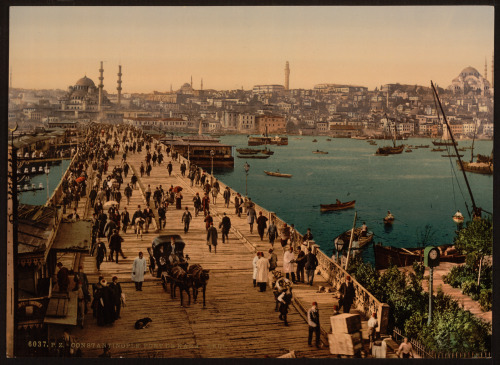
ANAMED Fellow Katinka Sewing reimagines Turkish poet Orhan Veli’s famous verse, ‘İstanbul’u dinliyorum, gözlerim kapalı / I am listening to Istanbul with my eyes closed’…
The Galata Köprüsü or Galata Bridge is one of my favorite places in Istanbul. For me, it is the perfect starting point for a trip to the Old City. Leaving the usually crowded and busy Istiklal Caddesi with its high buildings, it is always an inspiring moment to have the first glimpse at the bridge with its stunning panorama in the background. When the space opens towards this amazing view, you can already breathe the city`s history: Topkapı Sarayı, Hagia Sophia, the minarets of the numerous camis all over the city. Istanbul is waiting for you.
During the day, thousands of people constantly cross the Bosphorus from Karaköy and Eminönü, carried by the bridge. They can go by car, bus, or tram. Some of the bravest are even running or cycling. I prefer a walk over the Galata Köprüsü to watch the hopeful anglers and busy seagulls; and to wonder where all the ferries with so many Istanbullus and tourists on board might go. Underneath, the waiters from the string of fish restaurants solicit the patronage of their guests.
It is not surprising that this scenario inspired many creative people to write poems about Galata Köprüsü. One of my favorites is from Orhan Veli Kanık (1914–1950). He was a Turkish poet from Istanbul and one of the founders of the so-called Garip (“Strange”) Movement. This group of poets broke with the traditional style of Turkish poetry and created a more simple and realistic style including colloquial language. Orhan Veli’s house still exists as a café at Imam Adnan Sokak in Beyoğlu and is worth a visit to enjoy a Turkish coffee or a piece of their homemade cake. His well-known poem on Galata Köprüsü works with the repetition of phrases to depict the recurring daily routine. Moreover, he draws the atmosphere around the bridge very precisely and vividly.

Orhan Veli`s poem on Galata Köprüsü with two English translations.
This is quite remarkable, because Orhan Veli’s bridge is not the one we can see today. The very first bridge over the Golden Horn was already built in the 6th century, under the reign of Justinian the Great. But this bridge was erected in the western part of the city, close to the Theodosian Land Walls. The first bridge which was built at almost the same place as today’s Galata Köprüsü is from 1845. It was called the Cisr-i Cedid bridge and was built out of wood. This bridge was replaced by a second wooden bridge in 1863. The third (1875–1912) and the fourth (1912–1992) were both floating bridges. This means that they were made of connected shallow-draft boats or floated with a deck built on top of them, that they floated on the water. The present — fifth — bridge was completed in 1994, and the shops on the lower level opened in 2003. The main difference from the preceding constructions is that today’s bridge is a bascule bridge. The deck is movable, and its middle portion can be opened by raising two sections of the road.

The fish restaurants at the lower level and the anglers above.

The third bridge (1905).
While the architecture of the bridge has changed over the centuries, perhaps its spirit never has? Galata Köprüsü has always been a link between the ancient and more traditional quarters of Istanbul, and the lively mahalles (neighbourhoods) north of the Golden Horn, where foreign merchants and diplomats lived and worked, and also where I live now. For me, after a long and inspiring day in the Old City of Istanbul, the best part is to watch the blushing pink sunset at Galata Köprüsü on the way back home to ANAMED — competing with the illuminated Galata Kulesi. Maybe we can imagine Orhan Veli’s famous verse, ”İstanbul’u dinliyorum, gözlerim kapalı / I am listening to Istanbul with my eyes closed” as “İstanbul’u dinliyorum, gözlerim açık / I am listening to Istanbul with my eyes wide open.”

View from Eminönü towards Galata Köprüsü and Galata Kulesi.
Link for Orhan Veli’s poem: http://www.siirdefteri.com/?sayfa=siir&siir_id=1545
For the translation by Murat Nemet Nejat: http://www.cs.rpi.edu/~sibel/poetry/books/i_orhan_veli/92.html
For the translation by Talat Sait Halman: http://www.orhanveli.net/talathalman/thegalatabridge.html
For the picture in the background of the composition: https://i.ytimg.com/vi/bDtTf878JCI/maxresdefault.jpg
Link for fig. 5: https://commons.wikimedia.org/wiki/File:Kara-Keui_(Galata)_bridge,_Constantinople,_Turkey-LCCN2001699426.jpg

